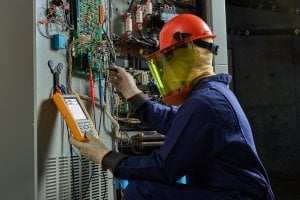
Life safety systems are required in every building type—from commercial and industrial to municipal, healthcare, and educational. The fire alarms, emergency lighting, evaluation and mass notification systems must be reliable to help ensure the safety of the building’s occupants. Equally important is that the tools used to verify the installation of those systems must also be reliably accurate.
To get an idea of the critical issues related to these systems, we spoke with Jesse, a Tech Supervisor who holds a Level III certification for fire alarms from the National Institute for Certification in Engineering Technologies (NICET). Jesse’s experience installing life safety systems has spanned nearly two decades.
Safety system installation
Hired electricians do the cabling in buildings, setting up all the field wiring and mounting the related peripherals. Jesse’s team goes in next to terminate the wires to the electronic circuit boards and run commission testing. Once the cabling and circuit boards are installed, Jesse and his crew run a pre-test to verify that everything they installed is working properly and meets all the specs required by the customer.
Jesse got his first Fluke digital multimeter during his freshman year of high school, and he’s been using Fluke test tools ever since. Today, Jesse relies on his trusty Fluke ScopeMeter® portable oscilloscope and digital multimeter to commission new installations.
“We use different technologies for various systems and some require the ability to view the sine wave over the two-pair wire that talks to the devices,” says Jesse. “I use my ScopeMeter a lot to verify that the communication between the field devices and the control panel are working properly. It shows that my sine wave is a true square all the way to the end, so I can make sure I don’t have noise on the wires.”
Commissioning reliable systems
Not long ago, Jesse used his ScopeMeter to solve a particularly prickly issue that could have had serious consequences. A new product his team installed had a problem communicating data with the field devices. After exhausting all the product company’s tech support without finding a solution, he decided to look deeper into the problem on his own.
“I scoped the circuits in question and found that the sine wave was rounded, causing the devices to report as different addresses,” says Jesse. He tracked the findings and sent a report to the product design engineers. They ended up changing the product’s firmware and issuing new calculation software to all the system designers.